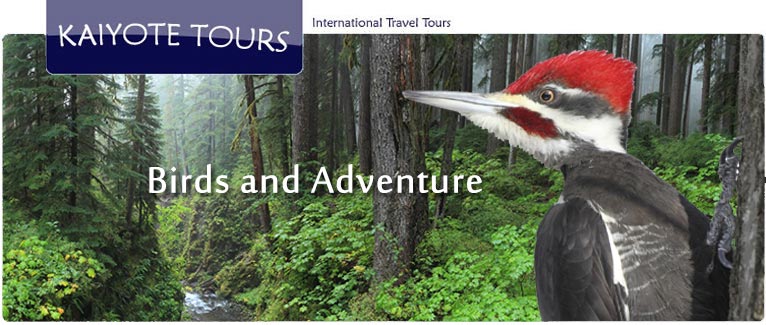Olympic National Park Guided Tours

If you are interested in Guided Tours in Olympic National Park, come and join us at Kaiyote Tours!
Trips for all levels from complete novice to expert:
In addition to our tours in Olympic National Park, we also offer multi-day birding and nature tours throughout Washington. Please check the Washington page for more details.
Fun, knowledgeable and experienced local guides for your Olympic Peninsula adventure.
All of our tours are educational and follow Leave No Trace principles.
You will learn about the natural history of Olympic National Park and its intricate bio-diversity and life in balance.
You will learn how to travel through the wilderness and Leave No Trace.
You will have fun!
Olympic National Park was established in 1938 and the paperwork was signed by President Franklin Roosevelt. Preservation of land on the Olympic Peninsula goes back to President Grover Cleveland, who established the Olympic Forest Reserve in 1887. By the late 1800's, logging the old growth forest was well underway and early explorers and conservationists urged the federal government to slow the logging and protect the forests. With the establishment of the National Forest Service in 1905 by President Theodore Roosevelt, the Olympic Forest Reserve, previously controlled by the Department of Interior, was transferred to the National Forest Service within the Department of Agriculture. During this time, the movement to establish national parks and preserve the west was in full swing. In 1909, Teddy Roosevelt established the Olympic National Monument to protect the habitat of the huge herds of elk that reside on the Olympic Peninsula. Teddy Roosevelt was a big game hunter and understood that all animals need intact and healthy habitats for survival. For twenty-nine years after that, it was a big political battle to move the designation of Olympic National Monument to Olympic National Park. A president can create a national monument, but only congress can create a national park. The trees of the Olympic Peninsula where so valuable as a timber source, for many it was seen as an economic mistake not to sell the trees to support the economy and create jobs. During WWI and long afterwards, large amounts of Sitka Spruce trees were harvested, both legally and illegally for use in the building of airplanes. Sitka Spruce trees have the best weight to strength ratio and made excellent material for aircraft. It is not a coincidence that Boeing started building planes in Washington state. Olympic National Park currently protects 922,650 acres.
Kaiyote Tours is authorized by the National Park Service, Department of Interior, to conduct services in Olympic National Park. Kaiyote Tours holds a commercial use permit to conduct services in Olympic National Forest and Washington State Park lands.
Washington State has six volcanoes along its segment of the Pacific Ring of Fire; Mount Saint Helen’s is currently the most active having awoke recently for a short time in 2008. The massive ridge of volcanoes, which extends from Northern California to southern British Columbia, is called the Cascade Range and is 700 miles long, with an average width of about 80 miles and has a total of thirteen volcanoes.
The Olympic Peninsula is located 90 west of the Cascade Range and if you viewed the Olympic Peninsula from above, nearly right in the center you would see the glacier capped summit of Mount Olympus rising to an elevation of 7,980 feet and you would easily assume that Mount Olympus is also a volcano and that which created the Olympic Peninsula, but you would be very wrong. If you hiked to the summit, you could easily visualize the summit edges forming a crater like shape, but you would be very surprised to find the mountain is almost entirely made of sedimentary rock. Sedimentary rock at nearly 8,000 feet? What is going on? Well, travel back in time with me to see what geology can tell us.
Sedimentary Rock is generally created over eons of time when rock is eroded into small particles, mainly via wind and water, and then flows to the bottom of the ocean where it is compressed and hardened into a new layer of rock. On the Olympic Peninsula this compressed sediment mostly creates shale. Over time there are different geological events that can create a specific type of erosion period, which can be represented by individual layers of sedimentary rock. For millions of years on the western edge of the North American continental landmass, which later would become the Olympic Peninsula, much of the ocean floor was layered by massive flows of sediments in the form of turbidites. Turbidites are sediments that are moved by high-density water flows similar to a slurry and those flows can carry larger rocks further and deeper into the ocean depths. Sometimes turbidites are the result of underwater landslides and all these different forms of movement create a specific type of settling and sifting of debris, which is the story of the Olympic Peninsula that the rocks can tell us.
Magma, Lava and Volcanoes: About 34 million years ago, while all the sediments and turbidites where tumbling to the ocean floor, the Pacific and North American tectonic plates where on the move and the unlucky Farallon Plate was caught in between. The Pacific Plate is oceanic, which makes it more dense and heavier than the North American Plate and so the Pacific Plate slides under the North American Plate in a process that is called subduction. But what about the Farallon Plate? It has mostly been crushed and compressed underneath the leading edge of the North American Plate and today it exists as three very small remnant tectonic plates: The Explorer, Juan de Fuca, and Gorda Plates. But the Farallon Plate was fairly large, so what happened to the huge mass of land? Well, most of it was compressed deep into the Earth’s crust and was heated and reformed into magma. The huge volume of magma (molten rock beneath the earth’s surface), which created immense pressure that built up under the western leading edge of the North American Plate, was released vertically and vented through volcanoes in the form of lava (magma that reaches the earth’s surface). Voilà!
Accretion Debris and Slabs: Although most of the Farallon Tectonic Plate was crushed beneath the western edge of the North American Plate, that leading edge of the North American Plate has significant weight that cut into and scraped off the top layers of the Farallon Plate and the extremely large pile of debris that landed on top of the western edge of the North American Plate is called “Accretion”. This process of accretion and uplift is responsible for creating mountains as far east as the Rocky Mountains: You got to really think BIG, when it comes to geology. And so, what is the Olympic Peninsula? It is nothing more than a huge pile of accretion debris.
Pillow Lava: Besides sedimentary rock, however, there are other types of rock on the Olympic Peninsula, mainly basalt, which is an extrusive igneous rock. This rock type has volcanic origins, but was created from eruptions on the ocean floor where the lava cooled quickly while it was exposed and then later through tectonic uplift and erosion has made it to the surface. Often these types of basalt formations are called “Pillow Lava”. In Olympic National Park, the Klahhane Ridge area, including Mount Angeles, has risen up to an elevation of 6,453 feet, having once been on the ocean floor and it is a great example of pillow lava.
Granite: There probably is some granite that originates from beneath the Olympic Peninsula, but granite is an intrusive igneous rock; meaning it formed and cool slowly beneath the earth’s surface and then later through tectonic uplift and erosion has made it to the surface and it is unlikely this event happened in a subduction zone in the Pacific Northwest. Most of the granite on the Olympic Peninsula probably originated in Canada and was brought to the peninsula by riding and being pushed along by numerous glaciers over time; perhaps even traveling a 100-miles or so from the source of origin in the Canadian Cascades. On the north side of the Olympic Peninsula when we hike along the beach, we find a lot of smooth granite rocks which have been polished by both the glaciers and the ocean, but if you travel down the west coast; you will find less and less granite the further south you go.
Sunshine at last! The rocks atop Mount Olympus are about 50 million years old, but have seen sunlight for only about 12 million years. If you get a chance to visit Hurricane Ridge in Olympic National Park at an elevation at 5,242 feet, you will find a lot of sedimentary rock and interestingly, most of it is laying on its side from having been pushed and folded onto itself during the accretion process. It is estimated that there could be as much as 12 miles of “Siletzia” accretion atop the subducting slab below, most of which is still below sea level. The Olympic Peninsula and Mount Olympus are just the tip of the accretion wedge. Don’t forget to think really BIG!
And then came the glaciers: Periods of glaciation have come and gone for about 2.6 million years. These numerous glaciers have been the sculptors of the land, another form of erosion, but one that leaves incredible beauty behind when it recedes. The Cordilleran Ice Sheet and the Vashon Glacial Period are partly responsible for the shape and face of the Pacific Northwest.
And then came the people: About 16,000 years ago the last glaciers started to recede and life quickly arrived and flourished on the newly exposed lands. The Olympic Peninsula has nine native tribes, which are descendants from the first people and it is believed humans have been on the peninsula for about 12,000 years.
And then came more people: Explorers from Europe started arriving along the coast as early as 1513 and the Spanish Conquistador Vasco Balboa, claimed the Pacific Northwest for Spain. Then came the English, then the French and then the Americans, it’s long story…. By 1818, the Pacific Northwest was part of what the United States called Oregon Country. In 1862, President Lincoln designate 3,500 acres of land on the Olympic Peninsula as a federal reserve for military purposes, (this land would later become the town of Port Angeles). On November 11, 1889, Washington became the 42nd State: The Evergreen State.
Preservation of the Olympic Peninsula goes back to President Grover Cleveland, who established the Olympic Forest Reserve in 1887. By the late 1800's, logging the old growth forest was well underway and early explorers and conservationists urged the federal government to slow the logging and protect the forests. With the establishment of the National Forest Service in 1905 by President Theodore Roosevelt, the Olympic Forest Reserve, previously controlled by the Department of Interior, was transferred to the National Forest Service within the Department of Agriculture. During this time, the movement to establish national parks and preserve the west was in full swing. In 1909, by an act of executive order, Teddy Roosevelt established the Olympic National Monument to protect the habitat of the huge herds of elk that reside on the Olympic Peninsula. Teddy Roosevelt was a big game hunter and understood that all animals need intact and healthy habitats for survival. For twenty-nine years after that, it was a big political battle to move the designation of Olympic National Monument to Olympic National Park. Olympic National Park was established in 1938 and the paperwork was signed by President Franklin Roosevelt (Teddy’s distant cousin). Olympic National Park currently protects 922,650 acres. The trees of the Olympic Peninsula where so valuable as a timber source, for many it was seen as an economic mistake not to sell the trees to support the economy and create jobs. During WWI and long afterwards, large amounts of Sitka Spruce trees were harvested, both legally and illegally for use in the building of airplanes. Sitka Spruce trees have the best weight to strength ratio and made excellent material for aircraft. It is not a coincidence that Boeing started building planes in Washington state.
For extra credit! National Park vs National Monument: A president can create a national monument, but only congress can create a national park. Here is why it matters: The Antiquities Act of 1906 authorizes a president to proclaim national monuments on federal lands that contain historic landmarks, structures, or objects of historic or scientific interest. This law was created to enable a president to act quickly when needed and this is not a permanent act and any president that follows can reverse that decision, which happens every time we have a new president, especially in regards to land. In contrast, to create a national park, it is decided by congress and this takes time, debate and compromise. It is a long process, which involves the voices and wishes of the American people and the final creation of a national park is viewed as permanent after the president signs the paperwork. The congress can also create national monuments. For example: Both President Clinton and President Obama set aside large tracts of land as national monuments, only to have those decisions reversed by the succeeding presidents, but a president cannot undo a national park.
I have been a tour guide since 1998: Guiding tours in Rocky Mountain National Park since 1998, in Olympic National Park since 2014, and at the Great Sand Dunes National Park since 2021. One of the most common questions and misunderstandings that people have is the difference between the forest service and the park service. Here's a little insight into the difference:
For Example: On the Olympic Peninsula in Washington State, we have both Olympic National Park and Olympic National Forest. When people refer to “the park”, they are talking about land regulated by the Department of Interior. When people refer to “the forest”, they are talking about land regulated by the Department of Agriculture. There is a big difference between agencies and keep reading and you can find out why.
The United States government owns about 650 million acres of land, it’s a lot of land and to put that into perspective: The two largest private land owners in the United States are John Malone (2.2 million acres) and Ted Turner (2 million acres). The state of Connecticut is just over 3 million acres.
It might be best to start at the beginning: Although we consider July 4, 1776 the birth date of our nation, the Revolutionary War lasted until September 3, 1783 and didn’t officially end until May 12, 1784, which was nearly nine years of war. The US constitution was written in 1787, ratified in 1788 and became effective March 4, 1789 (a long 13 years after the Declaration of Independence). In 1789, the executive branch had three departments: State, War and Treasury; seemed simple enough…. In 1849 the Department of the Interior was created to handle all domestic issues regarding land and especially the resources of the American West; the country was expanding fast.
Currently there are three major departments that oversee most of the federal land in the United States: The Department of Agriculture, the Department of Interior, and the Department of Defense (formerly the War Department).
Department of Agriculture: Created by President Abraham Lincoln 1862, Lincoln wanted to make American lives better and since most American were farmers, the best way to proceed was to make them better farmers, including better home economics. Today most people are not farmers and 80% of the $140 billion budget helps to feed and house Americans through programs such as SNAP (Supplemental Nutrition Assistance Program), which we used to call “Food Stamps”.
The Department of Agriculture oversees the National Forest Service, which manages 190 million acres of land, which is nearly 30% of total federal land. The Forest Reserve act of 1891 allowed for land to be moved from the Dept of Interior to the USDA. The Forest Service was created by Teddy Roosevelt in 1905 and Roosevelt appointed Gifford Pinchot as the department chief. The United States is divided into nine national forest regions and every state is included, but 80% of forest service lands are in the western United States. Most regions are designated as national forests, but there are also national grasslands and most regions allow for “resource extraction” (logging, hunting, mining, grazing etc.). Because extraction is allowed, these areas usually allow for a wide range of recreational uses like mountain biking, dog walking, snowmobiling, ATV’s, etc. Some forest service areas are designated “Wilderness Act” areas (similar to national parks), which offers the highest level of federal land protection, including protection of flora and fauna, which then also limits the types of recreational uses allowed. The “shape and face” of many national forests is constantly changing and will look different to future generations.
Fire Fighting: The National Forest Service has a $5 billion budget and about half of it is spent on fire management. In the year 1910, just 5 years after the formation of the forest service, the largest forest fire in US history occurred and burned nearly 3 million acres in Washington, Idaho and Montana and killed 87 people. Sometimes called the “Great Fire” it had a huge impact on the future management of western lands. There is an excellent PBS video: “The Big Burn” (Inspired by Timothy Egan's bestseller book) on the subject. By 1911, the federal fire policy was that all fire was bad and this philosophy was not officially changed until the 1964 Wilderness Act, which allowed for very limited fires to burn in remote areas. But it was the Yellowstone National Park fire of 1988 which really caused the national fire policy to slowly begin changing and to include fire as necessary for healthy forests.
The Department of Interior: manages 450 million acres of land, which is about 70% of all federal land. The department has numerous domestic responsibilities, four important ones involving land are: The Bureau of Indian Affairs, the National Park Service, the U.S. Fish and Wildlife Service and the Bureau of Land Management (BLM).
The Department of the Interior oversees the Bureau of Indian Affairs: The native Americans have had a very complicated relationship with the federal government, to say the least. 55 million acres of land are “held in trust” by the federal government for native tribes. The United States holds legal title to these lands, but the tribes own the right to use and benefit from the land.
The Department of the Interior oversees the National Park Service: Established is 1916, the park service manages all national parks, monuments, and historic sites. Its mission is to protect and preserve for future generations and also to provide public access. The park service manages about 80 million acres of land, including buildings, bridges, statues, etc. Many national parks have designated “1964 Wilderness Act” areas, which offers the highest level of federal land protection, but which also greatly limits the types of recreational uses allowed. In contrast to the national forest, the “shape and face” of park service land and monuments, will largely be unchanged for future generations and hopefully those generations will see the same landscape and monuments as we do today.
The Department of the Interior oversees the U.S. Fish and Wildlife Service: The USFWS manages all the national wildlife refuges, about 150 million acres, mostly for land preservation, but allows for “resource extraction” (logging, hunting, mining, grazing, etc.)
The Department of the Interior oversees the Bureau of Land Management: The BLM manages 240 million acres, which is nearly 40% of total federal lands. The mission of the BLM is "to sustain the health, diversity, and productivity of the public lands for the use and enjoyment of present and future generations." Originally BLM holdings were often described as "land nobody wanted" because homesteaders had no interest and sometimes the land is referred to as “extraction and grazing land”. President Harry S. Truman created the BLM in 1946 by combining two existing agencies: The General Land Office and the Grazing Service.
The Department of Defense (formerly the War Department), one of the original executive departments, controls over 10 million acres in the United States and another 15 million acres overseas.
I hope this clears up any confusion about "who is who" when it comes to federal land management.











 Follow
Follow

